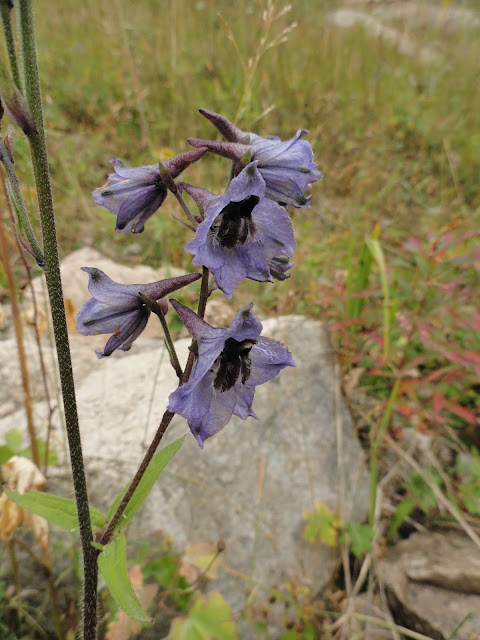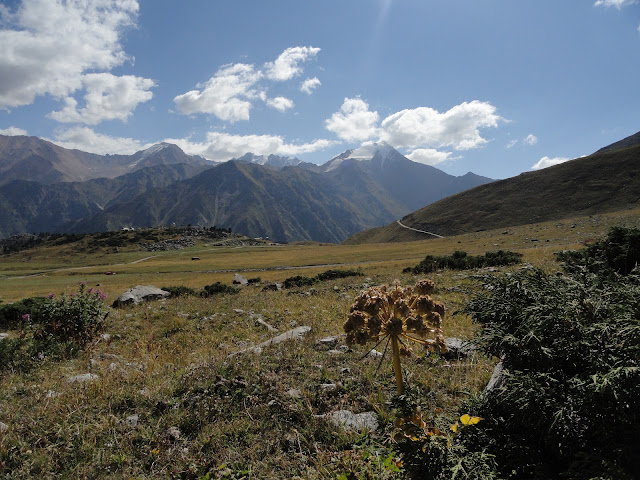Lomatagonium cf. carinthiacum
Despite the lateness of the season, we found a surprising number of wildflowers still blooming in late August and September. Some, like the Lomatogonium, were very familiar--we have a nearly identical species in the Rockies.
Comastoma falcatum
This too has a cousin in the Rockies: Comastoma tenellum is nowhere nearly as striking and beautiful as this miniature gem.
Comastoma falcatum
Here it is rising out of a mat of Sibbaldia cuneata.
Sedum (Hylotelephium ewersii) and Epilobium latifolium
Strange bedmates! We found the sedum elsewhere, but usually on dry rocky slopes. Here there had to be some extra moisture to support the fireweed.
Hylotelephium ewersii
The form we found in the Tian Shan and Altai was much more robust than what is in cultivation currently.
Epilobium latifolium
In Colorado this is rather rare, and usually grows along streamsides. Obviously a different ecotype.
Geranium saxatile
I have grown and still grow this micro-form of G. pratense. Mine isn't so winsome!
The high tundra looks pretty bleak from afar. Closer up there are no end of treasures!
Saxifraga hirculus
We have this species in the Rockies--looking quite different actually. We are twelve time zones separate!
Pyrethrum tianshanicum
A wonderfully diverse group in Central Asia---this alpine species was striking.
Dracocephalum imberbe
Dracocephalum is a much underappreciated genus. And there are many of the best species found in Central Asia--this one high alpine.
Dracocephalum imberbe
Dracocephalum imberbe
Schmalhausenia nidulans
It's worth growing this species for the name alone! Some of us like thistles.
Schmalhausenia nidulans
Saussurea gnaphalodes
Mike Bone photographing Paraquilegia microphylla in seed
Visiting this mountain in Soviet times was verboten: that was apparently some sort of Nuclear bomb facility in the distance they put above treeline in the Tian Shan--God only knows what inspired them. Must have been hell to work in much of the alpine year.
Delphinium iliense
Possibly Delphinium confusum instead: The specific epithet says it all.
Delphinium iliense
I love how different the same plant looks in different lights.
Delphinium iliense
( or Delphinium confusum as the case may be: corrections welcome. I would certainly love to grow this!
Aconitum rotundifolium
We saw several aconites over our two trips--one lovelier than the next.
We did stop from time to time to enjoy the scenery and aquamarine glacial lakes...
Dianthus hoeltzeri
One of the few dianthus we found on these mountains--but a lovely one.
We did find Codonopsis clematidea on our first trip, which was very different. Although superficially like a Codonopsis, I'm pretty sure this is a Campanula--and it didn't fit any of the species on our checklist. Any guesses?
Semenovia transiliensis
A virtually unknown genus of perennials with a striking resemblance to the Mediterranean genus Orlaya. Here growing with Veronica porphyrantha.
Semenovia transiliensis
Gentiana cf. prostrata
Nothing matching this on our checklist--but this is a dead-ringer for our Western American G. prostrata: if it isn't that, it's close!
Ranunculus rubrocalyx
One of very few buttercups we came across--but a beauty.
Achillea millefolium
Strange to find the Universal yarrow--but in a stunning color variation.
Angelica brevicaulis
Another anomaly: we have an almost identical dwarf Angelica in the Rockies (A. grayi) . They stopped feeling like coincidences after a while...
Angelica brevicaulis
Ziziphora bungeana
This is slowly becoming established as a garden plant in Colorado: quite different from its cousins, the thymes. Its aroma is heavenly--and apparently the plant is commonly brewed for tea in Central Asia.
Goodyera repens
Once again, I find a plant far away that also grows in Colorado (albeit rather rare and only on Pikes Peak) I'll be driving up Pikes Peak part way tomorrow--maybe I should Google the location!
I wouldn't mind this in my woodland garden, although the hardy gem of the genus is undoubtedly G. pubescens from the Eastern woodlands.
Rhodiola (Clementsia0 semenovii
One of the plants I was most anxious to see--this succulent is manifestly closely allied to Rhodiola (Clementsia) rhodantha, endemic to the Southern Rockies (primarily in Colorado). Bill Weber, leading Colorado botanist of much of the last century (he passed away last year at over 100) gave this as the supreme example of the twinship of Colorado and Altai floras. We never saw it in the Altai, but did see lots of it on the Tian Shan. It was segregated from the primarily umbellate Rhodiolas because of its thyrse-like inflorescence. I don't buy the split.
Rhodiola (Clementsia0 semenovii
Not nearly as colorful as our bright pink Queen's crown, it is nonetheless striking en mass.
Euphrasia aff. macrocalyx
The identification. is tentative. There are apparently hundreds in the genus. This species was recorded from the Tian Shan, hence my ID.
Gentiana kirilowii
Not the most striking gentian. But not the dowdiest either! It has turned out to be quite easy and long lived in the garden.
Gentiana kirilowii
Cystopteris fragilis
Another old friend: just as ferns are rather inconspicuous and often small in the Rockies, they are few and far between in Central Asia. This, along with bracken, is probably the most Universal of ferns.
Rheum wittrockii
We saw a number of species of rhubarbs on the trip--all rather local and not terribly abundant: we did see people selling the stems along the roads--which may explain their rarity.
Aster alpinus
The checklist only had one Aster for this area: and it does somewhat resemble Aster alpinus from Europe...but I will not be surprised if it's segregated one day into another species.
That's it for now: As COVID-19 rages on, I may find myself traveling more and more through my files and image libraries, which are admitedly in need of attention. And more mythical images from my past may resurface from time to time!
I also want to acknowledge the support of Plant Select, and thank Pat Hayward who was executive director at the time, for underwriting both trips we undertook to Central Asia.




















































Maybe you could explore Alaska while other countries don't want visitors from the United States. I am told all that is needed to visit is a negative Covid-19 test.
ReplyDeleteI'd love to go to Alaska--any time from May to September: I've been there once in July for two and a half weeks with my whole family and we didn't see one mosquito! There's apparently a midsummer lull among the hummers. So June or August, then!
ReplyDelete